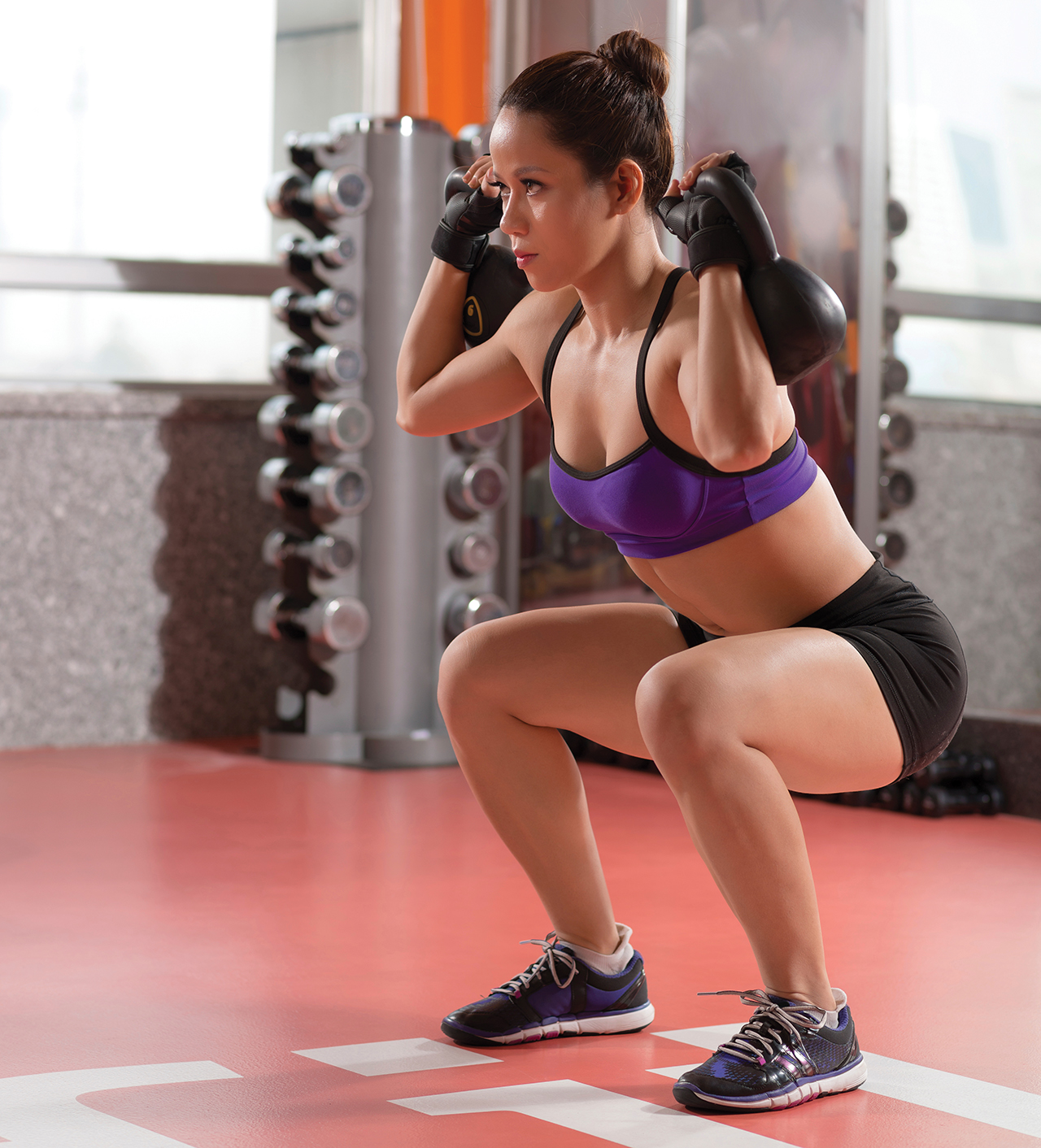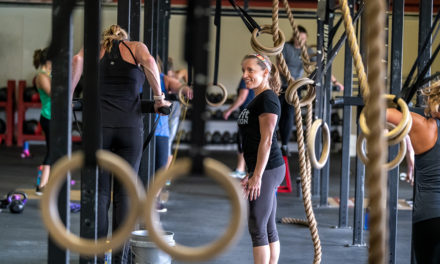High-intensity interval training is popular for a reason—because it works. The upsides include relatively short workouts and killer muscle tone. But don’t expect it to be easy. HIIT makes you work for it.
There’s a training technique that’s proven to blast body fat and boost overall fitness in a fraction of the time it takes to run 5 miles or complete a spin class. The only problem: you have to push yourself really hard to do it. And that’s been the drawback to high-intensity interval training (HIIT) for years. Just out of habit, most of us shy away from any activity with the word intense in the name. But new approaches to HIIT have made it more accessible than ever.
HIIT alternates intense bursts of exercise with brief active recovery moves. And by intense, we’re talking about raising your heart rate to 80 percent of its maximum. This kind of effort makes it hard to talk or breath or even think clearly sometimes. “The interval nature of HIIT training means your heart speeds up and slows down several times, which improves the overall cardiac benefit,” says Michael Ast, M.D., director of Outpatient Joint Replacement at Mercer Bucks Orthopaedics. “And most HIIT workouts include several different muscle groups within a single workout, which provides a total-body workout more consistently than cardio alone.”
How To Do It
HIIT sessions can be worked into many different exercises, from cycling and swimming to elliptical cross-training and group exercises. “You can use heart rate to gauge your effort, keeping above 80 percent of your maximum heart rate, but a lot of times you need to individualize these numbers for yourself,” says Dr. Saxena. “Max heart rate is often found through age-based calculations, but if you’re a marathon runner, you’re going to be able to handle a lot more cardiovascularly than someone who has been sedentary for the last 10 years.”
If you don’t have a heart rate monitor, you can approximate the right effort level for a HIIT workout through a talk test. If you’re struggling to speak in full sentences, you’re probably above 80 percent of your max heart rate. Starting out, it’s more important to get a feeling for what this effort level feels like and to get your body accustomed to exercising at this intensity, says Dr. Saxena. HIIT workout reps may range from 5 seconds to 8 minutes, with the recovery reps often lasting just as long.
“The concept is to have short intervals of maximal oxygen consumption and physical energy output combined with intervals of about 50 percent oxygen consumption or 50 percent physical energy output,” says Dr. Bezwada. Finding the right approach to HIIT comes down to controlling how hard you do each individual workout and how closely you spaced each rep from the next.
The key, according to Lisa Ojert, group fitness instructor at Central Bucks Family YMCA in Doylestown, Pa., is to take a conservative approach to each workout and gradually add more per session. “You can always rest more if you need to,” she says.
Ojert has been teaching HIIT classes for more than 4 years and loves the variety of exercises that the format allows. Her set routines frequently include a mixture of burpees, box jumps, and mountain climbers, and she’s used the training technique with everything from bootcamp classes to tough mudder training. “When done right, HIIT workouts go so quickly that you don’t ever get bored,” she says.
Ojert was introduced to HIIT through Tabata, one of the most popular forms of HIIT. Developed in the 1970s for Japanese Olympic speed skaters, Tabata focuses on short sets that redline your heart rate for a short period of time and offer brief intervals in between. “For Tabata, you perform a high-intensity exercise for 20 seconds, and then follow with 10 seconds of rest,” says Ojert. “Repeat this eight times to complete a 4-minute Tabata round.”
Given Tabata’s intensity, Ojert doesn’t recommend it for beginners and says that anyone interested in HIIT should first establish a base level of fitness that includes 30 minutes of aerobic exercise at least 3 days a week. “The best way to introduce HIIT into your workout regime is to try a simple 10-minute program of 20-second bursts and 40-second recovery intervals for 10 minutes,” says Dr. Bezwada. “You can do this on a bicycle, treadmill, elliptical, or rower.” He adds that once your body adjusts to this routine, then you can add another session to your week.
Most HIIT workouts include several different muscle groups within a single workout, which provides a total-body workout more consistently than cardio alone.
—Michael Ast, Mercer Bucks Orthopaedics.
Why Is HIIT So Effective?
HIIT, long popular with elite athletes and highly motivated individuals, has only started to catch on with the average gym goer in recent years. Several studies have shown that even a few minutes of these intervals can substantially improve your aerobic fitness and supercharge your body’s ability to burn fat.
It offers plenty of health benefits, too. “HIIT works well at reducing the risk of Type II Diabetes by decreasing insulin resistance,” says Hari Bezwada, M.D., of Princeton Orthopaedic AssociatesMarjorie G. Ernest Joint Replacement Center of Excellence and medical director of the at Capital Health Medical Center – Hopewell.
“Studies have shown that blood glucose is lower following HIIT than normal continuous exercise. Therefore, it has a greater impact on preventing obesity. Secondary benefits are obvious and include improved cardiac health, overall fitness, reduced abdominal fat, and improved cholesterol profiles.”
HIIT is so potent because your body works harder both while intensely exercising and while recovering from your hard workout. “With HIIT, the period of post-exercise oxygen consumption burns 6 to 15 percent more calories than traditional workouts,” says Dr. Bezwada. The scientific name for this effect is excess post-exercise oxygen consumption (EPOC), and it measures the amount of oxygen required to restore your body to its normal, resting metabolic level. “For example, spinning as fast as you can on an exercise bike instead of at a light pace causes your body to have a tougher time recovering, which causes it to burn more calories during the recovery phase,” says Arjun Saxena, M.D., an orthopedic surgeon with Trenton Orthopaedic Group.

Squats are a compound movement, which means they use multiple joints (your hip and knee joints) to complete. Since they engage so many muscle groups, they help strengthen your entire body, including your bones and your muscles (and your knees) and increase flexibility.
Getting Started
When you start out, it is reasonable to incorporate HIIT into your workout regimen once or twice a week. “Some studies have found that you shouldn’t do high-intensity interval training more than twice a week, even when you’re at a good fitness level, so we still aren’t sure how much HIIT is appropriate,” says Dr. Saxena. “You should do low-intensity exercises, such as yoga or tai chi and even strength training on the other days. It’s all part of a balanced workout program.”
He recommends women do their homework before starting HIIT. “You want to make sure you’re safe for it, which means talking to your doctor, especially if you have any history of heart disease, high blood pressure, or diabetes,” says Dr. Saxena. “You should also work with a trainer or go to a class to start your interval training right.” He stresses how important it is to maintain correct form while doing HIIT exercises so it doesn’t result in injuries. Since there is often a wide range of exercises in a single HIIT session, it can be easy to forget proper form during transition.
“HIIT addresses many different muscle groups within a single workout, and sometimes these may be muscle groups a person has not worked on in a while or ever before,” says Dr. Ast. “Pace yourself, and build the appropriate stamina and fitness before getting too intense with HIIT.” As with any exercise routine, he recommends warming up and cooling down as well as stretching before and after each workout to avoid injuries.
“In terms of our joints as we age, there’s no such thing as “no pain, no gain,” says Dr. Ast. “If an exercise hurts certain joints, you should avoid or modify that exercise so that you don’t aggravate an underlying condition. Protecting our joints is of the utmost importance, especially as we age.” Given the adaptable nature of HIIT, it’s best to modify the workouts to your body and your fitness and never hesitate to avoid an exercise that hurts, or even modify the intensity to avoid injury. Whatever you do, keep it challenging and fun so you keep coming back for more.






